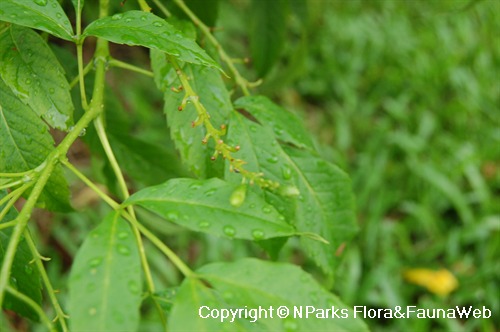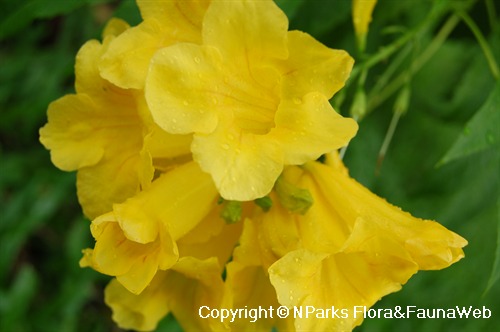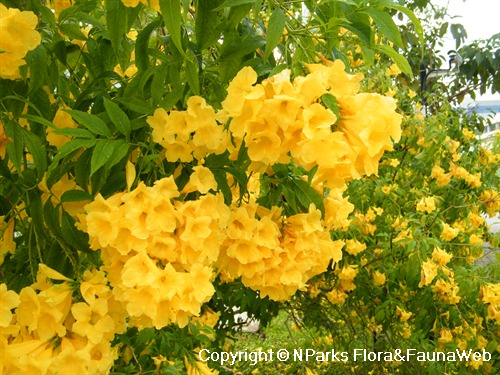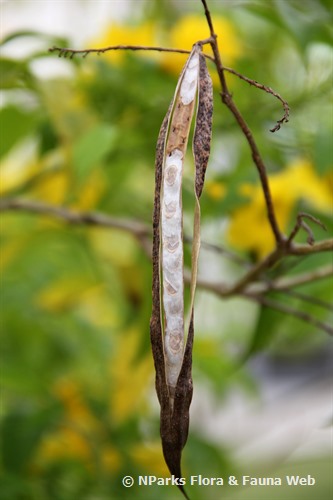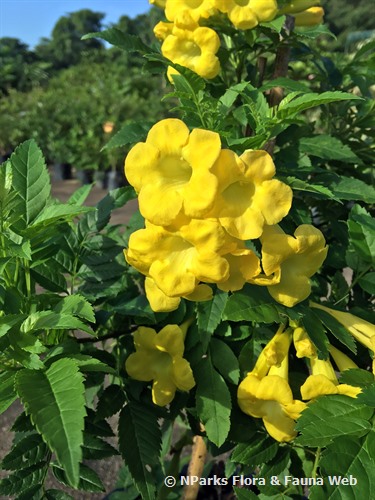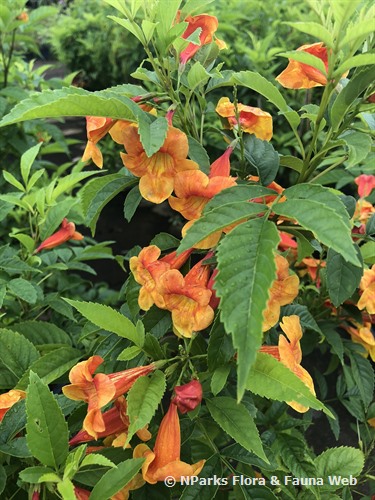
Back
Tecoma stans (L.) Juss. ex Kunth
| Family Name: | Bignoniaceae |
| Synonyms: | Bignonia stans L. |
| Common Name: | Golden Bells, Yellow Bells, Yellow Bignonia, Trumpet Tree, Ramat Emas, Yellow Trumpet Flowers, Yellow Elder |
Name
Classifications and Characteristics
| Plant Division | Angiosperms (Flowering Seed Plants) (Dicotyledon) |
|---|---|
| Plant Growth Form | Shrub, Tree |
| Lifespan (in Singapore) | Perennial |
| Mode of Nutrition | Autotrophic |
| Plant Shape | Irregular |
| Maximum Height | 10 m |
Biogeography
| Native Distribution | West Indies, Mexico to Peru |
|---|---|
| Native Habitat | Terrestrial |
| Preferred Climate Zone | Tropical, Sub-Tropical / Monsoonal |
| Local Conservation Status | Non-native (Horticultural / Cultivated Only) |
Description and Ethnobotany
| Growth Form | It is a shrub or small tree, up to 10 m tall. |
|---|---|
| Foliage | Its opposite, stalked, compound leaves are pinnate, bearing 3-7 elliptic to elliptic-ovate leaflets with toothed margins. |
| Flowers | Its fragrant, bright yellow tubular flowers are borne on a short, upright, terminal inflorescence. Each flower measures about 3 cm long. |
| Fruit | Its fruits are elongated and flattened, measuring up to 30 cm long and 2 cm wide. The fruits matures from green to brown and split open to release numerous seeds which are papery and winged. The seeds are flat, and oblong in shape, measuring up to 8 mm long and about 4 mm wide. Together with the wings, they are about 2 cm long and 0.8 mm wide. |
| Associated Fauna | Its flowers are known to attract bees, butterflies and sunbirds for its nectar. |
| Cultivation | It can be propagated by seed. |
| Etymology | Latin Tecoma, from Mexican name of the plant, tecomaxochitl. Latin stans, self-supporting, upright, erect, standing, referring to the upright inflorescence. |
| Ethnobotanical Uses | Medicinal: Its primary applications have been in treating diabetes and digestive problems. Extracts from Tecoma stans leaves have been found to inhibit the growth of the yeast infection, Candida albicans. |
Landscaping Features
| Landscaping | It is suitable for roadsides, parks and gardens for its fragrant and attractive bright yellow flowers. |
|---|---|
| Desirable Plant Features | Ornamental Flowers, Fragrant (Flowers) (Day) |
| Landscape Uses | General, Flowerbed / Border, Hedge / Screening, Parks & Gardens, Small Gardens |
| Thematic Landscaping | Golden Garden, Fragrant / Aromatherapy Garden |
Fauna, Pollination and Dispersal
| Fauna Pollination Dispersal Associated Fauna | Bird-Attracting (Flowers), Butterfly-Attracting (Flower Nectar), Bee-Attracting |
|---|---|
| Pollination Method(s) | Biotic (Fauna) |
| Seed or Spore Dispersal | Abiotic |
Plant Care and Propagation
| Light Preference | Full Sun |
|---|---|
| Water Preference | Moderate Water |
| Plant Growth Rate | Moderate |
| Rootzone Tolerance | Well-Drained Soils, Drought Tolerant, Moist Soils, Fertile Loamy Soils |
| Propagation Method | Seed |
Foliar
| Foliage Retention | Evergreen |
|---|---|
| Mature Foliage Colour(s) | Green |
| Mature Foliage Texture(s) | Leathery |
| Foliar Type | Compound (Odd-Pinnate) |
| Foliar Arrangement Along Stem | Opposite |
| Foliar Shape(s) | Non-Palm Foliage |
| Foliar Venation | Pinnate / Net |
| Foliar Margin | Serrate / Toothed |
| Leaf Area Index (LAI) for Green Plot Ratio | 4.5 (Shrub & Groundcover - Dicot) |
Floral (Angiosperm)
| Flower & Plant Sexuality | Bisexual Flowers |
| Flower Colour(s) | Yellow / Golden |
|---|---|
| Flower Grouping | Cluster / Inflorescence |
| Flower Location | Terminal |
| Flower Symmetry | Bilateral |
| Individual Flower Shape | Campaulate / Bell-shaped, Tubular |
| Flower Size - Remarks | 2.5-5.1 cm |
| Flowering Habit | Polycarpic |
Fruit, Seed and Spore
| Mature Fruit Colour(s) | Brown |
|---|---|
| Fruit Classification | Simple Fruit |
| Fruit Type | Dehiscent Dry Fruit , Capsule |
Image Repository
Others
| Master ID | 1884 |
|---|---|
| Species ID | 3177 |
| Flora Disclaimer | The information in this website has been compiled from reliable sources, such as reference works on medicinal plants. It is not a substitute for medical advice or treatment and NParks does not purport to provide any medical advice. Readers should always consult his/her physician before using or consuming a plant for medicinal purposes. |


